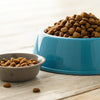What's Better: Dry or Wet Dog Food?
- Houndsy
Table of Contents
- Introduction
- Understanding Dog Nutrition
- Benefits of Dry Dog Food
- Benefits of Wet Dog Food
- Drawbacks of Dry Dog Food
- Drawbacks of Wet Dog Food
- Special Considerations Based on Your Dog’s Health and Lifestyle
- Mixing Dry and Wet Dog Food
- Choosing High-Quality Dog Food Brands
- Conclusion
Introduction
As dog owners, we often find ourselves pondering the best choices for our furry friends. Did you know that nearly 50% of dog owners are uncertain about whether to choose dry or wet dog food for their pets? This statistic highlights a widespread dilemma that many pet parents face. Feeding our dogs is not just about filling their bowls; it’s about ensuring they receive the right nutrition, hydration, and enjoyment from their meals.
In this blog, we’ll explore the essential aspects of dry and wet dog food, diving into their nutritional content, benefits, and drawbacks. By the end, you’ll have a comprehensive understanding of the differences between these two types of dog food, enabling you to make informed choices tailored to your dog’s specific needs.
We will cover the following topics:
- The nutritional profiles of dry and wet dog food
- The benefits and drawbacks of each type
- Special considerations based on your dog’s health and lifestyle
- Tips on mixing dry and wet food for optimal nutrition
- Recommendations on selecting high-quality dog food brands
So, let’s embark on this journey together, ensuring that our four-legged companions receive the best possible care and nourishment.
Understanding Dog Nutrition
When it comes to our pets, nutrition is the cornerstone of their health and well-being. Dogs require a balanced diet that includes proteins, carbohydrates, fats, vitamins, and minerals. However, how these nutrients are delivered can vary significantly between dry and wet dog food.
Nutritional Composition
-
Dry Dog Food (Kibble)
- Moisture Content: Typically contains around 5-10% moisture.
- Protein and Fat: Generally, dry dog food has a higher carbohydrate percentage and lower fat content than wet food.
- Vitamins and Minerals: Many brands fortify kibble with essential vitamins and minerals; some also include probiotics to support digestive health.
-
Wet Dog Food
- Moisture Content: Contains about 75-85% moisture, making it a hydrating option for dogs.
- Protein and Fat: Often higher in protein and fat, making it a more palatable choice for some dogs.
- Vitamins and Minerals: Similar to dry food, high-quality wet food contains necessary nutrients, but the concentration may vary.
By understanding these compositions, we can better choose the right food based on our dog's specific dietary needs.
Benefits of Dry Dog Food
There are several advantages to feeding dry dog food, which we’ll explore in detail.
1. Convenience and Storage
Dry dog food is incredibly convenient. It can be stored easily, is less messy, and doesn’t spoil as quickly as wet food. For pet parents who live busy lives, kibble is a practical choice that can be left out for grazing throughout the day.
2. Dental Health Benefits
The crunchiness of kibble helps reduce tartar build-up on dogs’ teeth, promoting better dental health. While it doesn't replace the need for regular dental care, feeding dry food can contribute positively to your dog's oral hygiene.
3. Cost-Effectiveness
In general, dry dog food tends to be more economical compared to wet food. The lower moisture content means that you get more nutrients in a smaller package, which can be beneficial for larger dogs or families with multiple pets.
4. Nutrient Density
Due to its lower moisture content, dry dog food is often more nutrient-dense than wet food. This means that pet owners may need to feed less volume of kibble to meet their dog’s nutritional requirements.
5. Enhanced Cognitive Engagement
Kibble can be used in puzzles, slow feeders, or training exercises, providing mental stimulation for dogs. This enrichment can improve their overall quality of life by keeping them engaged and active.
Benefits of Wet Dog Food
While dry food has its advantages, wet dog food offers unique benefits as well.
1. Higher Moisture Content
Wet dog food's high moisture content can be beneficial for dogs that do not drink enough water, helping to maintain hydration levels. This is especially important for dogs with urinary or kidney issues.
2. Increased Palatability
Many dogs find wet food more appealing due to its aroma and texture, which can entice even the pickiest eaters. If your dog is recovering from illness or experiencing a decreased appetite, wet food may be a more effective option.
3. Easier to Chew
For older dogs or those with dental issues, wet food can be easier to chew and digest. Its soft texture makes it more manageable for pets with missing teeth or other oral problems.
4. Satiety
Wet food often creates a feeling of fullness, which can aid in weight management. This is particularly helpful for dogs that tend to overeat, as they can feel satisfied without consuming excessive calories.
5. Variety of Flavors and Textures
Wet dog food comes in various flavors and textures, allowing pet owners to provide a diverse diet for their dogs. Mixing different types can keep mealtime exciting and engaging for your furry friend.
Drawbacks of Dry Dog Food
While there are many benefits to dry dog food, some drawbacks should also be considered:
1. Less Moisture
Dogs that primarily eat dry food may be at risk of dehydration if they don’t drink enough water. It's essential to monitor your dog’s water intake, especially if they eat kibble.
2. Less Flavorful
Some dogs may find dry food less appealing than wet food, which can lead to decreased appetite. For picky eaters, kibble may not be the best choice.
3. Potential for Overeating
Because kibble can be left out for grazing, some dogs may overeat, leading to obesity or digestive issues. Pet owners should monitor their dog's food intake carefully.
Drawbacks of Wet Dog Food
Wet dog food comes with its own set of challenges:
1. Spoilage
Once opened, wet food can spoil quickly, requiring careful storage and serving. If left out too long, it can lead to waste and potential health hazards for your dog.
2. Higher Cost
Generally, wet food is more expensive than dry food, especially for larger dogs. The higher price can add up significantly over time.
3. Dental Health Concerns
While wet food is easier to chew, it does not provide the same dental benefits as dry food. Dogs that primarily eat wet food may experience more dental issues over time.
4. Nutritional Imbalance
Not all wet foods are created equal. Some brands may contain fillers or lack essential nutrients, making it crucial to choose high-quality options that provide balanced nutrition.
Special Considerations Based on Your Dog’s Health and Lifestyle
When deciding between dry and wet dog food, it’s essential to consider your dog’s specific health needs and lifestyle:
- Age: Puppies, adults, and senior dogs have different nutritional requirements. Consult your veterinarian for tailored recommendations based on your dog's life stage.
- Health Conditions: Dogs with certain health issues may benefit from specific diets. For example, dogs with kidney problems may require higher moisture intake, making wet food a better choice.
- Activity Level: Active dogs may require higher protein and fat content, which may be found in wet food. Conversely, less active dogs may do well on dry food due to its lower calorie density.
Mixing Dry and Wet Dog Food
An excellent option for many pet owners is to mix dry and wet dog food. This approach allows you to provide the benefits of both types while catering to your dog’s preferences and nutritional needs.
1. Balanced Nutrition
By combining dry and wet food, you can create a balanced diet that includes the hydration benefits of wet food and the dental health advantages of kibble. This mix can also enhance palatability, making mealtime more enjoyable.
2. Adjusting Portions
When mixing foods, it’s crucial to adjust the portion sizes to avoid overfeeding. Consult your veterinarian for guidance on appropriate calorie counts based on your dog's needs.
3. Experiment with Ratios
Every dog is different, so feel free to experiment with different ratios of wet to dry food. Start with a 50/50 split and adjust based on your dog's preferences and health needs.
4. Monitor Health Responses
As you introduce a mixed diet, keep a close eye on your dog’s health and behavior. If you notice any allergies, digestive issues, or changes in appetite, consult your veterinarian for further guidance.
Choosing High-Quality Dog Food Brands
Regardless of whether you choose dry or wet food, selecting high-quality brands is essential for your dog’s health. Here are a few tips to help you choose:
- Read Labels: Look for dog foods that list high-quality protein sources and avoid fillers or artificial ingredients.
- Consult Your Vet: Your veterinarian can recommend specific brands based on your dog’s unique needs and health status.
- Consider Life Stage Formulas: Ensure the food you choose is appropriate for your dog’s age, size, and activity level.
Some popular brands that are often recommended by veterinarians include Hill's Science Diet, Royal Canin, and Purina Pro Plan.
Conclusion
Ultimately, the decision between dry or wet dog food comes down to your dog’s individual needs, preferences, and health status. Both types of food offer unique benefits, and many pet owners find that a combination of the two works best. By understanding the nutritional compositions, advantages, and potential drawbacks, we can make informed choices that contribute to our dogs’ overall health and happiness.
As we navigate the world of pet care, let’s also enhance our feeding rituals. The Houndsy Kibble Dispenser can elevate the experience of feeding your dog. With its sleek design and ergonomic features, it simplifies meal times while adding a touch of elegance to your home. Explore our Houndsy Kibble Dispenser to make your dog’s feeding experience as enjoyable as possible.
FAQ
1. Can I mix dry and wet dog food? Yes, mixing dry and wet dog food can provide a balanced diet and enhance palatability. Just adjust portion sizes to avoid overfeeding.
2. Is wet food better for older dogs? Wet food can be beneficial for older dogs due to its softer texture and higher moisture content, making it easier for them to eat.
3. How do I choose the best dog food? Look for high-quality brands, consult your veterinarian, and consider your dog's specific needs, including age, health conditions, and activity level.
4. Can dry food help with dental health? Yes, the crunchy texture of dry food can help reduce tartar buildup and promote better dental hygiene.
5. How can I ensure my dog stays hydrated? If feeding dry food, ensure your dog has constant access to fresh water. Consider incorporating wet food into their diet for added hydration.












